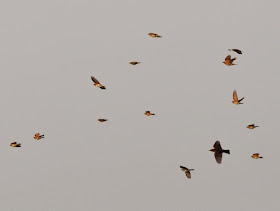 |
| Redwing 29/11/14 |
 |
| Continental Song Thrushes, like this bird, are more olive grey from the nape to the upper tail coverts compared to the British race which have warm brown upperparts. |
 |
| Continental birds are also much whiter underneath with much less buff on the breast. |
 |
| Yellowhammer with a twist. |
 |
 |
| It must be really difficult for this bird to pick up seeds. |
 |
| There was a coating of soil on the end of the upper mandible which suggests it scrapes the ground when the bird is feeding. |
 |
 |
| The plumage was in pristine condition so it must be managing to preen well enough. |
 |
| Normal Yellowhammer for comparison. |
 |
| Paul releasing his first Yellowhammer. |
 |
| Kestrel 29/11/14 |
 |
| Kestrel 29/11/14 |
 |
| Reed Bunting 29/11/14 |





































